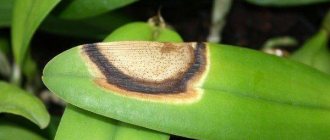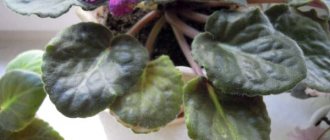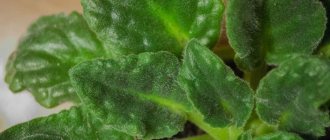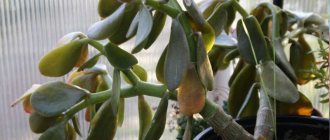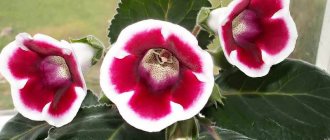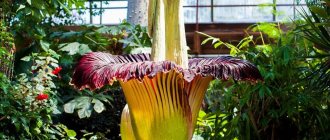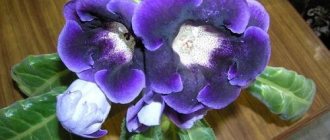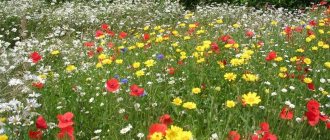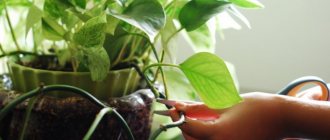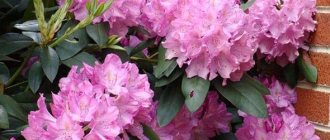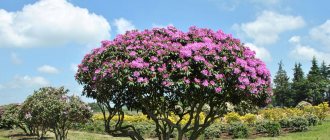Fantastically beautiful and abundantly blooming rhododendron is a decoration for any area. This shrub from the Ericaceae family has dozens of varieties of all bush sizes with beautiful leathery leaves and varied flower colors. And even the tropical origin of the plant does not scare anyone today - many of its frost-resistant forms have been bred.
If you have chosen an acclimatized variety of rhododendron that is suitable for your site, planted it correctly and take care of the plant, does this mean that the shrub is no longer afraid of any misfortunes?
Alas, no - although rhododendron is a crop that is quite resistant to diseases and pests, it can still be exposed to various diseases under poor conditions, improper agricultural practices or the vagaries of the weather. Susceptibility to such negative factors mainly depends on the type and variety of the plant - for example, young and/or depleted rhododendrons growing in full sun rather than in partial shade are most vulnerable.
Poor health of rhododendron is often manifested precisely by modifications of leaf blades - their curvature and/or growth retardation, coupled with new growths of different colors. The leaves of this plant can lose their healthy appearance due to several diseases, mainly of a fungal nature.
Rust
Chrysomyx fungus most often affects small-leaved rhododendrons, although it can also occur on other species.
Symptoms : The infection affects only the crown, without affecting the roots or buds. In autumn, “rusty” yellow, red or brownish dusty swellings (sporangia) appear on the underside of the leaves of affected plants. Severely infected plants drop their leaves prematurely. In spring, dark red spore pads are visible on the leaves - the winter form of the fungus. Without timely treatment, the disease leads to the death of shoots and death of the entire plant.
Control measures : affected leaves are collected and burned. Sick plants are treated with copper-containing preparations. In the early stages of this disease, spraying plants with Bordeaux mixture or its substitutes helps.
Prevention of occurrence : do not create areas near pine forests, avoid excessive application of nitrogen fertilizers, and in the fall carefully remove all plant debris - leaves, broken shoots, fallen fruits.
- Plant rust - signs of the disease and ways to combat it
If the leaves of the plant are covered with spots with a touch of yellow, red, red (less often brown) shades, then most likely the crop has been affected by rust.
Why does the greenery not develop at all or does it poorly, what to do in this case?
Let's consider what are the main reasons that greenery has sprouted but does not develop.
Natural causes
We exclude natural causes (it’s not time yet). Typically, dill begins to be planted in early spring. Cucumbers, legumes, potatoes are the best predecessors for planting.
Poor quality seeds
Bad seeds are one of the main reasons for poor fruiting of dill. To be sure of the quality of the raw materials for planting this spice, you need to take care of it yourself and use your own seeds.
Grains must be collected from a plant already grown in the garden
It is very important to store them correctly, do not expose them to moisture and avoid exposure to direct sunlight. If you don’t have your own seeds, experienced gardeners strongly advise purchasing them at the pharmacy.
Poor soil or lack of fertilizer
Increased soil acidity is death for dill. It is necessary that the soil is sufficiently moist. Fertilizers play an important role.
With proper planting and proper care, dill grows lush and fragrant. In dry and cracked soil, the crop will sprout too early and the seeds from such a plant cannot be used for planting next year.
That is why it is very important to monitor soil moisture and fertility, especially in summer. Dill must be planted in well-prepared soil.
It should be loose and fertile. If your garden bed cannot boast of such qualities, you need to fertilize it in advance.
In the spring, chicken droppings or manure are added to the ground while digging. To avoid infertile soil next year, it is necessary to apply mineral fertilizers to it in the fall. For autumn digging, 2-3 kg of humus per square meter is added to a depth of 20-25 cm.
Diseases and pests
The most common disease for the spice is powdery mildew. The first sign of fungal spread is the presence of a white coating. To combat this disease, use a solution of potassium permanganate or preparations containing copper.
To prevent this disease in the future, carefully monitor the condition of your plantings. Infected areas with greenery must be removed. Blackleg can also attack your dill plantings. The first sign is a rotting stem, which begins to turn black and leads to the death of the plant.
The drug Fundazol will help in the fight against this disease. The cause of the disease can be not only too much watering, but also sharp temperature fluctuations, lack of loosening, and crust on the soil surface.
To avoid such problems, it is necessary to monitor the condition of the soil and apply mineral fertilizers on time. If the plant turns red, look for one of two reasons.
- First, the soil is oversaturated with ash and lime, as well as phosphorus. It is strictly prohibited to apply such fertilizers.
- The second reason is Fusarium disease. In case of mass infection, it is necessary to remove infected plants and monitor the spread of the disease.
Aphids are a fairly common pest of dill. To prevent the fight against these parasites, do not plant densely. It is recommended to plant mallow and chamomile next to them. Aphids cannot tolerate the smell of these plants. The umbrella moth can also attack your dill plantings.
To combat it, it is necessary to collect the infected plant and burn it. For prevention, it is necessary to destroy wild umbrella crops in the area.
Read more about diseases and pests of dill here.
Improper care
This reason can also get in the way of a good dill harvest (read about how to get a good dill harvest and why the greens turn yellow). In order to avoid this, you must adhere to the following rules:
- It is necessary to water the dill beds 2-3 times a week, but do not overwater them.
- Before planting seeds, it is necessary to apply mineral fertilizers, and to obtain lush greenery, water with humus.
- Make it a rule to weed the dill bed.
- Thinning and loosening the soil with spice will give excellent results.
- In hot weather, it is necessary to install a canopy over the garden bed.
If you follow these recommendations, you will receive a fragrant, lush and rich harvest of dill that will delight you all year round.
Septoria spot (small spot)
The Septoria fungus most often “attacks” rhododendrons in greenhouses, although it is also found on deciduous species in open ground.
Symptoms : Small rounded reddish or yellowish-brown spots of irregular shape appear on the leaves, gradually turning white or blackening in the center. Over time, the spots grow, and pinpoint black fruiting bodies of the overwintering stage of the fungus form on their surface. The leaves turn yellow and gradually dry out and fall off. As a result, all physiological processes in plants are disrupted and flower buds do not form normally.
Control measures : affected leaves are collected and burned at the earliest stages of disease development. Sick plants are treated with copper-containing preparations (use only at normal air humidity and a sufficiently high temperature). In the early stages of this disease, spraying plants with Bordeaux mixture or Cumulus fungicide helps.
Prevention of appearance : in the fall, treat the inside surface of greenhouses, dig the soil deeply and carefully remove all plant debris - leaves, broken shoots, fallen fruits.
- Septoria, or white spotting - signs of the disease and methods of treatment
Are the leaves of your plants covered with strange dark spots that are actively growing? It's time to sound the alarm - perhaps it's septoria.
Rhododendron pests
The shrub is often attacked by pests. Timely treatment will avoid the death of the plant.
The photo identifier will help you identify the insect that causes rhododendron disease, accurately select the treatment regimen, dosage and the right drug.
The most common pests:
- The grooved weevil is a black beetle, 8–10 mm long, that lays white larvae in the ground that gnaw at the roots. Rhododendron suddenly withers and dies. Adults damage the leaf blades: eaten away areas appear along the edges. Treatment includes spraying with Splender, Iskra, Decis, Actellik.
- Spider mites actively reproduce in hot, dry weather. It is almost impossible to notice even an adult: the size of the tick does not exceed 0.5 mm. A symptom of its appearance is a thin web covering the underside of the leaf plate, buds, and buds of the rhododendron. Treatment: treatment with Fufanon, colloidal sulfur, Actellik, Fitoverm, Karbofos.
- The acacia false scale insect is a large (up to 6.5 cm) insect, light brown in color. The pest, attaching its proboscis to young trunks, damages the bark and feeds on plant juices. Rhododendron leaves become sticky. Gradually the bush weakens, loses its decorative appearance, and dies. Treatment: spraying with Fitoverm, Karbofos, Fufan, Aktelik, phosphorus-containing compounds.
- Tobacco thrips is a yellowish-brown winged insect about 1 mm long. An adult female is able to lay up to 100 eggs in the tissue of the leaf blade. On rhododendrons, the pest most often affects the buds. They do not open, turn yellow and fall off. Thrips is a carrier of dangerous viruses. Treatment: disinfection with neonicotinoids, organophosphorus compounds, pyrethroids and other insecticides.
- Rhododendron mite - settles on varieties with a pubescent lower part of the leaf blade. When infected, the plant turns yellow and dark spots appear on it. If the rhododendron leaves turn black and fall off, the disease is already advanced. It is not difficult to see a tick; an adult reaches 3.5 mm, a larva – 2.5 mm. Treatment: manual collection of insects - at an early stage, as well as preventive spraying with nicotine or pyrethrum extract; in case of advanced disease - complete removal of shoots.
- Whitefly – carries viral diseases. The parasite is most often found on large-leaved rhododendrons. Treatment: treatment of shoots with neonicitinoids, nicotine-based pesticides.
- Mollusks, snails, slugs - appear when there is excessive soil or air moisture. Pests attack buds, young shoots, and buds. Treatment includes: manual collection, treatment with insecticides.
Important! In case of pest infestation, a thorough autumn cleaning of the area is carried out. Fallen rhododendron leaves are burned, the soil is treated with insecticides, and the trees and shrubs remaining in the garden are sprayed with potent drugs.
Anthracnose spot
The pathogenic fungus most often affects young rhododendron plants.
Symptoms : On the upper part of the leaves, marginal necrosis appears in the form of brown-brown spots of irregular shape. The leaves gradually dry out. On the surface of the spots, sporulation forms in the form of numerous rounded dark-colored fruiting bodies. If the infection continues to develop, the stems are also affected, which eventually dry out, weakening the plants. The disease is spreading rapidly.
Control measures : pruning and destruction of affected parts of plants, spring spraying with a solution of Bordeaux mixture or Cumulus fungicide.
Prevention of occurrence : do not allow the plantings to become dense, dig up the soil deeply in the fall, treat the inside surface of the greenhouses and carefully remove all plant debris - leaves, broken shoots, fallen fruits.
- Anthracnose: photo and description of the disease, how and how to treat plants
Find out everything about this dangerous disease and how to combat it.
Phyllostictic brown spot
Fungal disease.
Symptoms : Round or irregularly shaped reddening (less often dark gray) spots with a thin dark brown border appear on rhododendron leaves (usually along the edges and ends). Subsequently, the affected areas lighten, crack and fall out. The vast majority of affected leaves die, and the process begins at the tips of the leaves. Black dotted bodies of the overwintering stage of the fungus form on the necrotic tissue.
Control measures : pruning and destruction of affected parts of plants, spring spraying with a solution of Bordeaux mixture or fungicide Cumulus, a suspension of Zineb or Captan.
Prevention of appearance : in the fall, dig up the soil deeply and carefully remove all plant debris - leaves, broken shoots, fallen fruits.
Pestalocia spot
Young plants are also more likely to suffer from the invasion of this fungus.
Symptoms : The fungus affects the leaves and stems of the plant, manifesting itself as small brown spots of irregular shape with a thin brown-yellow border. The spots are often scattered along the edges of the leaf blade, which turns yellow and dries out prematurely. Round gray pads of fungal sporulation form on patches of dying tissue. The spots on the stems are large, depressed, elongated. Over time, their surface dries out and becomes lighter, and numerous small gray pads of fungal sporulation are formed. Affected shoots dry out.
Control measures : pruning and destruction of affected parts of plants, spring spraying with a solution of Bordeaux mixture or Cumulus fungicide.
Prevention of appearance : in the fall, dig up the soil deeply and carefully remove all plant debris - leaves, broken shoots, fallen fruits.
Prevention and plant protection
Marigold diseases - why leaves dry out
In summer and spring, plants should be periodically sprayed with insecticides and fungicides. The soil should be moderately moist; plants do not like large amounts of water, but also do not grow in dry places. The soil must have good drainage for growth and flowering to occur.
Note! Most often, rhododendron suffers from a fungal infection. Gardeners prefer to spray the bushes with Bordeaux mixture, which destroys most types of mushrooms.
Rhododendron is often susceptible to diseases, the treatment of which depends on their cause. It can become infected with a bacterial or fungal infection. But the gardener must also take into account that a flower requires certain conditions in order for it to grow and bloom successfully. If the leaves of a rhododendron wither, this article will tell you what to do if you re-read it carefully. And it is advisable not to delay treatment, so as not to lose the entire bush overnight.
Non-infectious chlorosis
This disease, characterized by the appearance of light yellow spots on the leaves of rhododendron, can occur for many reasons - from incorrect agricultural practices to unfavorable soil and climatic conditions (increased soil acidity, deficiency of iron or magnesium in the soil, lack of nitrogen, increased salt content, waterlogging of roots and etc.).
Symptoms : The leaf blade between the conducting veins becomes light green or yellowish-green. In the initial stage of the lesion, the veins still retain a dark green color, later they also turn yellow. With severe chlorosis, all young shoots become yellow or simply pale; they easily get burned in the sun. Constant exposure to unfavorable factors leads to stunted growth and disease, even to the death of the plant.
Control measures : optimization of cultivation conditions - if necessary, liming the soil and/or adding missing elements, etc.
Prevention of occurrence : careful adherence to agricultural cultivation techniques, proper watering, timely fertilizing, normalization of soil acidity.
Wintering
Wintering is the most important stage in the care of rhododendrons. Next year's flowering depends on it.
Typically, deciduous varieties in the middle zone winter easier than evergreen ones.
Deciduous rhododendrons include:
- Japanese;
- Daurian;
- yellow;
- ledebura;
- Canadian;
- Schlippenbach.
There is no need to cover them, but just in case, you can cover only the root collar area with peat or dry leaves
.
However, with evergreen rhododendrons everything is much more complicated. Even winter-hardy plants (Katevba, Caucasian) are better covered. In winter, they do not freeze so much as they dry out - they need protection from the sun and wind. To do this, you can make houses from boards and cover them with roofing felt.
This shelter will not protect evergreen rhododendrons that are less resistant to frost. They will need houses covered with spongy insulating material (polyurethane foam, polypropylene foam). The house must have a frame
, otherwise the snow will bring it down and break the bush.
Cold weather can damage the root system of evergreen and deciduous rhododendrons, so it must first be insulated. As soon as low temperatures are established, the roots are covered with a dry leaf or acidic peat with a layer of at least 10–15 centimeters.
Wax disease (leaf swelling)
Fungi from the genus Exobasidium parasitize some types of rhododendron, preferring young plants.
Symptoms : deformation, enlargement and thickening of leaves and shoot tips, accompanied by the appearance of large, round or oblong red or red-brown spots. A dense waxy coating of sporulation develops on the surface of necrosis. Over time, the spots dry out and crack, and the spherical growths grow. Affected plants lose their decorative properties and bloom poorly. One type of fungus is also capable of causing the formation of the so-called “rhododendron witch’s broom” with yellowing of the foliage and a powdery coating on the bottom.
Control measures : pruning and destruction of affected parts of plants, spring spraying with a solution of Bordeaux mixture, its substitutes or Cumulus fungicide.
Prevention of appearance : in the fall, dig up the soil deeply and carefully remove all plant debris - leaves, broken shoots, fallen fruits.
Infectious diseases of shrubs
Tracheomycosis is a disease that has a fungal etiology. Vascular wilt (the second name of the disease) is caused by fungi of the genus Fusaria. The symptoms are very characteristic of this disease: active death of leaves and stems occurs, and a typical grayish coating appears. The disease is complicated by damage to the root system, and severe damage to the vascular system of the bush occurs. If an infection with fungi of this genus occurs, then you need to cut off and destroy the damaged parts as soon as possible. It is best to burn the branches to prevent further spread of the fungus. After this, it is necessary to treat the plant with Bordeaux mixture.
The disease late blight rot also refers to mycoses. It is caused by a fungus from the genus Phytophthora, which is why it got its name. The putrefactive process affects the stem and root collar, after which purple-brown defects form on this part of the plant. After some time, the process spreads to the rhizome, which leads to the death of the bush. As a therapeutic measure, it is necessary to reduce the frequency of watering, and treat the shrubs with products from the fungicide group.
Septoria spot. This disease is caused by fungi from the Septoria family. Leaves are usually affected, which is expressed by untimely (early) yellowing and falling off. The disease can also affect the stem apparatus. At an early stage, the disease can be differentiated after the appearance of round spots that turn red along the edges and have a pale tint in the middle. To treat this mycosis, you must first remove the affected leaves, and then treat the bush with copper sulfate or Bordeaux mixture. After about seven days, the procedure must be repeated.
Leaf mosaic. The cause is viruses carried by bedbugs, aphids and other types of insects. Alpine species of rhododendrons are the most vulnerable. If infected, the leaf becomes thinner and changes color to yellow. “Blisters” appear on the surface of the leaf - a small swelling of green color. When a bush is infected, it is necessary to destroy the plant so that the pathogen does not reach neighboring individuals. The fight against the vector of the virus is also important. To do this, you need to use the following drugs - Actellik, Confidor, and others.
Rhododendron rust occurs on small-leaved species. As the name implies, the symptoms are very simple - brown or yellow spots form on the leaves. A dark-colored “pad” appears directly on the diseased leaf - a certain form of sporulation. Substances containing copper are usually used.
Dying shoots. It manifests itself as a change in color to brown, unopened buds dry out and fall off. The etiology of the disease is fungi of the genus Phytophthora. If timely measures are not taken, the pathological process will spread to the stems and foliage, causing the death of the plant. If wilting of this nature has been noticed, the diseased branches should be destroyed in the fire. After this, it is necessary to treat the bush with quadris or a 0.2% solution of foundationazole.
Cercospora blight. Caused by fungi from the Cercospora family. Externally, the disease manifests itself as damage to the leaves - red or brown spots appear on the surface of the leaves. A gray coating forms on the outside of the leaf. For treatment, treatment should be done alternately with solutions of dithane and foundationazole.
Cercospora
The causative agent is the fungus Cercospora. The lower tiers of rhododendron leaves are more susceptible to damage.
Symptoms : Platinum leaves develop irregularly sized, dark brown, angular spots with reddish edges. A gray coating of sporulation appears on the front part of the leaf, clearly visible in humid weather. If left untreated, the disease progresses, the entire reverse side of the leaf turns brown, the shoots stop growing, and flowering does not occur. Without treatment, rhododendron may even die.
Control measures : pruning and destruction of affected parts of plants, treatment of affected plants according to instructions with Alirin-B, in more advanced cases with Ditan.
Prevention of occurrence : mandatory collection and burning of fallen leaves in the fall, loosening the soil after the onset of cold weather.
Late blight
Diseases of rhododendrons that originate in the soil have dangerous consequences. Diseases of rhododendrons caused by fungi in the soil are sometimes called wilt. These include late blight root rot, which leaves light brown, quickly darkening spots on infected roots. The diseased plant withers, completely or partially, the leaves curl, acquire a light green or grayish color, and the infected rhododendron stops growing. Action must be taken immediately, step by step. Diseased specimens are removed and burned, not forgetting to disinfect instruments after each action, and the plant is sprayed with a fungicide.
